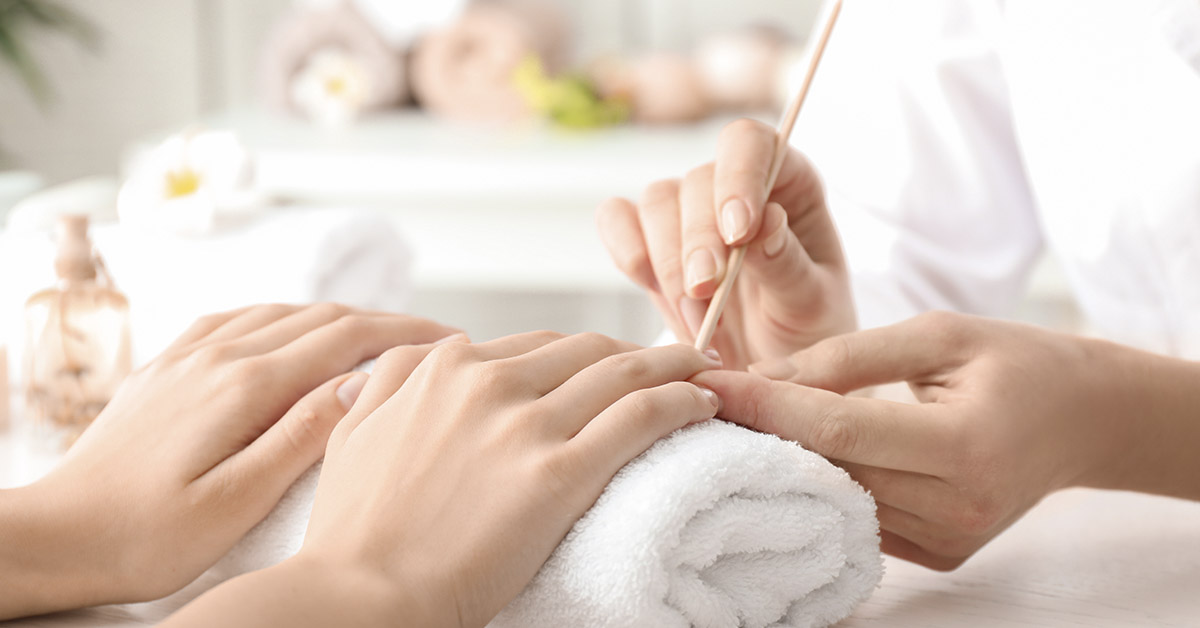A mother of two shares her scary experience of losing the ability to use her hands due to a presumed allergic reaction to nail products. Lisa Dewey from Pattishall, Northamptonshire, had been getting regular gel manicures for a long period without having any problems.
However, after a routine appointment in February, the 36-year-old noticed her fingers becoming inflamed, and her nails began to peel away. To make matters worse, one finger turned a rather scary shade of purple. Instilling fear in her that she might lose it.
Following a medical consultation, Mrs. Dewey was diagnosed with a bacterial infection. Her doctor prescribed a steroid cream and antibiotics for treatment. Unfortunately, after getting another manicure recently, her fingers have gotten significantly worse. Thus causing her immense pain and severely restricting her hand mobility.

Factoring in her symptoms, Lisa suspected her gel manicures had something to do with her issues
As an NHS cleaner, Mrs. Dewey has come to the realization that she may be allergic to something found in gel nail polish. This aligns with the growing concern raised by dermatologists in recent times. In February, Mrs. Dewey, a devoted mother of two girls aged three and 12, experienced an unexpected reaction shortly after having her usual gel nail treatment.
To her surprise, within a few days, her nails started peeling away from the nail bed. One even went a purple hue. Meanwhile, the rest of her nails became very itchy and extremely painful. Never before did she suspect that her fond manicure routine could be the source of such issues.
Reflecting on her lifelong habit of getting acrylics or gel nails, Mrs. Dewey shared. “I’ve been getting my nails done all my life. When it first occurred after getting a set of gels in February, I initially thought it was a bacterial infection.” Mrs. Dewey said.
Believing that the cause was an allergic reaction, Mrs. Dewey was convinced
Concern grew as her finger turned purple around the nail. Causing her to fear the possibility of losing a finger due to oxygen deprivation. However, the actual cause turned out to be something entirely different. Her doctors prescribed a course of antibiotics, assuming it was an infection.
After taking off the gels and a break from nail products, Mrs. Dewey believed the ordeal was behind her. Unfortunately, when she had acrylic nails applied again in April, the reaction got even worse. Not only did her fingernails begin to lift once more, but the skin around her nails became as delicate as paper.
Furthermore rendering her hands immobile due to the excruciating pain. Recently, she received a new prescription for a different medication to address her condition. While Mrs. Dewey did not disclose the specific medical opinion regarding the cause of her symptoms, she personally believes it to be an allergic reaction.
After years of treatments Lisa Dewey first had a problem earlier this year
— Plymouth Live (@Plymouth_Live) May 9, 2023
https://t.co/Bg1v77iHFG
Not alone, it seems gel manicures are causing problems more commonly than ever before
In line with her experience, the British Association of Dermatologists issued a related warning last month. Therein highlighting the increasing frequency with which medical professionals are treating individuals for allergic reactions related to acrylic and gel nails.
The British Association of Dermatologists issued a warning statement, attributing the common reaction to inadequately trained manicurists and the utilization of at-home gel polish kits. They highlighted that the reaction occurs when the UV light, needed for the polymerization process of the polish, is not applied for a sufficient duration.
This incomplete exposure to UV light can result in the leakage of methacrylates. The chemical components found in gel nail polish, into the skin. Consequently, individuals may experience nail detachment, skin rashes, and, in severe cases, even respiratory difficulties. Moreover, those affected may develop a lasting sensitivity or hypersensitivity to these chemicals, known as “life-long sensitization.”
The consequences of such a reaction can be significant. Affected individuals may face limitations in undergoing crucial future surgeries, including cataract procedures, joint replacements, or dental work. As these interventions involve exposure to the same chemicals that trigger their adverse reactions.
Read: Dermatologists Explain the Cause of Nail Fungus (and How to Fix It)
Now in constant discomfort, Lisa finds even the simplest tasks hard to do
Mrs. Dewey’s daily life has become challenging due to the persistent pain in her hands and nails, necessitating constant assistance from her husband, Lee, aged 45. She shared, “Simple tasks like washing my daughter’s hair have become difficult because it requires finger movements. Even securing her in the car seat becomes excruciating if my finger grazes the belt, as the raw skin intensifies the pain.”
“The condition worsens even with the use of gloves, as sweaty hands exacerbate the symptoms. Additionally, anything scented or fragranced aggravates the situation, preventing me from applying conditioning treatments or hair mousse.”

Determined to prioritize her well-being, Mrs. Dewey has made the decision to permanently avoid nail products. She is also committed to warning others about the associated risks. She expressed, “People can have years of nail treatments without any issues until one day it unexpectedly affects them. I had planned to get my hands and toes done for my upcoming August holiday, but now I have canceled those appointments. This experience has significantly impacted my confidence.”
“Normally, I am unconcerned about others’ opinions, but now I feel compelled to hide my hands. It’s truly embarrassing to have hands in this condition. There’s a celebration this week, but if my hands haven’t improved, I won’t be attending. I simply want to contribute by spreading awareness that things may not be as benign as they appear.”
Emily Craig, senior health reporter for MailOnline offers some insight into how the reaction initially occurs
“The chemicals in gel nail polishes, known as methacrylates, can trigger an allergic reaction if they leak into the skin. This can see nails loosen and the skin develops a severe, itchy rash. At-home gel manicures are the most likely culprit for triggering the painful reaction but even salon nail treatments can pose a risk if the technician is poorly-trained.”
“During gel manicures, methacrylates can enter the skin when the ultraviolet lamps — used to harden each layer of gel — are not used for long enough. It can also occur if the equipment is poorly maintained. If the gel is not sufficiently ‘cured’ for the correct period of time, a reaction to the chemicals may also occur on the skin around the nails.”
“Each gel polish brand has an exact curing time which should be adhered to, often either 30 seconds, 60 seconds or 90 seconds. But experts warned that nail technicians rushing clients out of salons when the gel is not sufficiently cured can also trigger an allergic reaction. Sufferers can have a ‘life-long sensitization’ to the chemicals.”
Keep Reading: What would happen if I never cut my fingernails?
Sources
- “I’ve got my nails done all my life and never had an issue – but now I can barely use my hands after suffering an agonising reaction to gel manicure.” Daily Mail UK. Emily Craig. May 8, 2023

